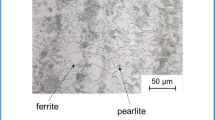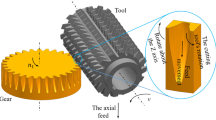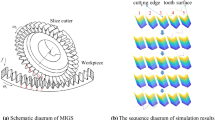Abstract
This paper addresses the problems of easy deformation, difficult dimensional control and difficult accuracy assurance during the production of thin-walled gears for helicopter spoke cutting. It uses finite element simulation technology, metal cutting principles, process optimization and other design and manufacturing technologies to reveal the causes of cutting deformation, effectively predict the deformation of parts during cutting, and develop reasonable deformation control strategies. This study explores the effects of cutting force, residual stress and clamping method on gear machining deformation. The deformation of the spoke plate is analysed by finite element simulation. Abaqus software is adopted to establish a finite element model for 2D turning simulation to predict the machining residual stresses and cutting forces during gear turning machining with different cutting parameters. The simulated cutting forces are compared with the residual stresses and experimentally measured values to verify the accuracy of the finite element model and provide a theoretical basis for model construction in the next simulation study. With Abaqus software, the effect of different cutting forces on the deformation of the spoke plate is simulated, and the effect of the superposition of cutting and clamping forces on the deformation of the spoke plate is simulated using life and death cell technology to simulate the machining of the workpiece. Then, a corresponding fixture is designed to realise the corresponding clamping position for machining experiments, and the deformation of the spoke plate is measured by CMM (coordinate measuring machine) to verify the realism of the simulation. This research provides scientific theoretical guidance and process support for aerospace thin-walled gear spoke plate turning.


















Similar content being viewed by others
References
Wang CL, Zhang XF, Zhou JX (2020) Calculation method of dynamic stress of flexible ring gear and dynamic characteristics analysis of thin-walled ring gear of planetary gear train[J]. J Vib Eng Technol 9:751–766
Young KA, Nervi S, Szabo B (2005) Machining-lnduced residual stress and distortion[J]. SAE Trans 114:1030–1038
Denkena B, Schmidt C, Krüger M (2010) Experimental investigationand modeling of thermal and mechanical influences on shape devia-tions in machining structural parts. Int J Mach Tools Manuf 50(11):1015–1021
Gao H, Zhang Y, Wu Q, Li B (2018) Investigation on influences of initial residual stress on thin-walled part machining deformation based on a semi-analytical model. J Mater Process Technol 262:437–448
Liu Y, Cui N, Chen H, Yan X, Zhao C, Bao K, Shan Y, Yin Z (2023) Effect of temperature on milling stability of thin-walled parts [J]. Proc Inst Mech Eng 237(3):414–423
Zhou H, Wang C, Jing X (2018) Influence of cutting and clamping forces on machining distortion of diesel engine connecting rod[J]. Int J Adv Manuf Technol 99:897–910
Fan ZQ, Cao LX, Liu F (2020) FEM analysis of the distortion of thin-walled sealing part affected by the machining-induced residual stress[J]. IOP Conf Ser Mater Sci Eng 768(4):042028
Wan M, Ye XY, Wen DY (2019) Modeling of machining-induced residual stresses[J]. J Mater Sci 54(1):1–35
Zhou RH, Yang WY (2019) Analytical modeling of machining-induced residual stresses in milling of complex surface[J]. Int J Adv Manuf Technol 105(1–4):565–577
Alarcon RH, Chueco JR, Pérez García JM (2010) Fixture knowledge model development and implementation based on a functional design approach[J]. Robot Comput Integr Manuf 26(1):56–66
Li GL, Du SC, Huang DL (2019) Elastic mechanics-based fixturing scheme optimization of variable stiffness structure workpieces for surface quality improvement[J]. Precis Eng 56:343–363
Zhang J, Lin B, Fei J (2018) Modelingand experimental validation for surface error caused by axial cuttingforce in end-milling process[J]. Int J Adv Manuf Technol 99:327–335
Frifita W, Salem SB, Haddad A, Yallese MA (2020) Optimization of machining parameters in turning of Inconel 718 Nickel-base super alloy[J]. Mech Ind 21:203
Krolczyk GM, Nieslony P, Maruda RW (2017) Dry cutting effect in turning of a duplex stainless steel as a key factor in clean production[J]. J Clean Prod 142:3343–3354
Sun Y, Jiang S (2018) Predictive modeling of chatter stability considering force-induced deformation effect in milling thin-walled parts[J]. Int J Mach Tools Manuf 135:38–52
Asad M, Mabrouki T, Ijaz H (2014) On the turning modeling and simulation: 2D and 3D FEM approaches[J]. Mech Ind 15(5):427–434
Wan M, Li SE, Yuan H (2018) Cutting force modelling in machining of fiber-reinforced polymer matrix composites (PMCs): a review[J]. Compos A 117:34–55
Deng Z H, Zhang X M, Yang Z Y (2020) Modeling and analysis of residual stress in dynamic orthogonal cutting[J]. Procedia CIRP 87(C):485–490
Du HH, To S, Yin TF (2022) Microstructured surface generation and cutting force prediction of pure titanium TA2[J]. Precis Eng 75:101–110
Wang B, He YP, Liu Y (2020) Thermodynamics of phase transformation and microstructure evolution of 18Cr2Ni4WA carburized steel during high-temperature tempering[J]. Steel Res Int 91(8):1–11
Dong GJ, Wang L, Li C (2020) Investigation on ultrasonic elliptical vibration boring of deep holes with large depth–diameter ratio for high-strength steel 18Cr2Ni4WA[J]. Int J Adv Manuf Technol 108:1–13
Zener C, Hollomon JH (1944) Effect of strain rate on plastic flow of steel. J Appl Phys 15(1):22–32
Johnson GR, Holmquist TJ (1988) Evaluation of cylinder-impact test data for constitutive model constants. J Appl Phys 64(8):3901–3910
Johnson GR, Cook WH (1985) Fracture characteristics of three metals subjected to various strains, strain rates, temperatures and pressures. Eng Fract Mech 21(1):31–48
Li LJ, Sun LY (2016) Experimental and numerical investigations of crack behavior and life prediction of 18Cr2Ni4WA steel subjected to repeated impact loading[J]. Eng Fail Anal 65:11–25
Miller L, Zhou K, Tang J (2021) Thermomechanical finite element simulation and correlation analysis for orthogonal cutting of normalized AISI 9310 steels[J]. Int J Adv Manuf Technol 114(11–12):1–20
Funding
This study was supported by the 2020 Open Project of the National Key Laboratory of Helicopter Transmission Technology (Project grant no.: 4HTL-O-20G04).
Author information
Authors and Affiliations
Contributions
All authors contributed to the study concept and design. The project declaration was conducted by J.X., and the material preparation, data collection, and analysis were conducted by H. H., K.Z. and W.X. The first draft of the manuscript was written by K.Z., the formatting of the paper was revised, the English statements were touched up by M.W., and all authors commented on previous versions of the manuscript. All authors read and approved the final manuscript.
Corresponding author
Ethics declarations
Consent to participate
All authors know and agree to be co-authors.
Consent for publication
All authors agreed to be published.
Conflict of interest
The authors declare no competing interests.
Additional information
Publisher's note
Springer Nature remains neutral with regard to jurisdictional claims in published maps and institutional affiliations.
I would like to declare on behalf of my co-authors that the work described was an application that has not been published previously and not under consideration for publication elsewhere, in whole or in part.
Rights and permissions
Springer Nature or its licensor (e.g. a society or other partner) holds exclusive rights to this article under a publishing agreement with the author(s) or other rightsholder(s); author self-archiving of the accepted manuscript version of this article is solely governed by the terms of such publishing agreement and applicable law.
About this article
Cite this article
Huan, H., Zhang, K., Xu, J. et al. Machining deformation control methods and analysis of a thin-walled gear spoke plate. Int J Adv Manuf Technol 127, 1317–1331 (2023). https://doi.org/10.1007/s00170-023-11609-5
Received:
Accepted:
Published:
Issue Date:
DOI: https://doi.org/10.1007/s00170-023-11609-5




